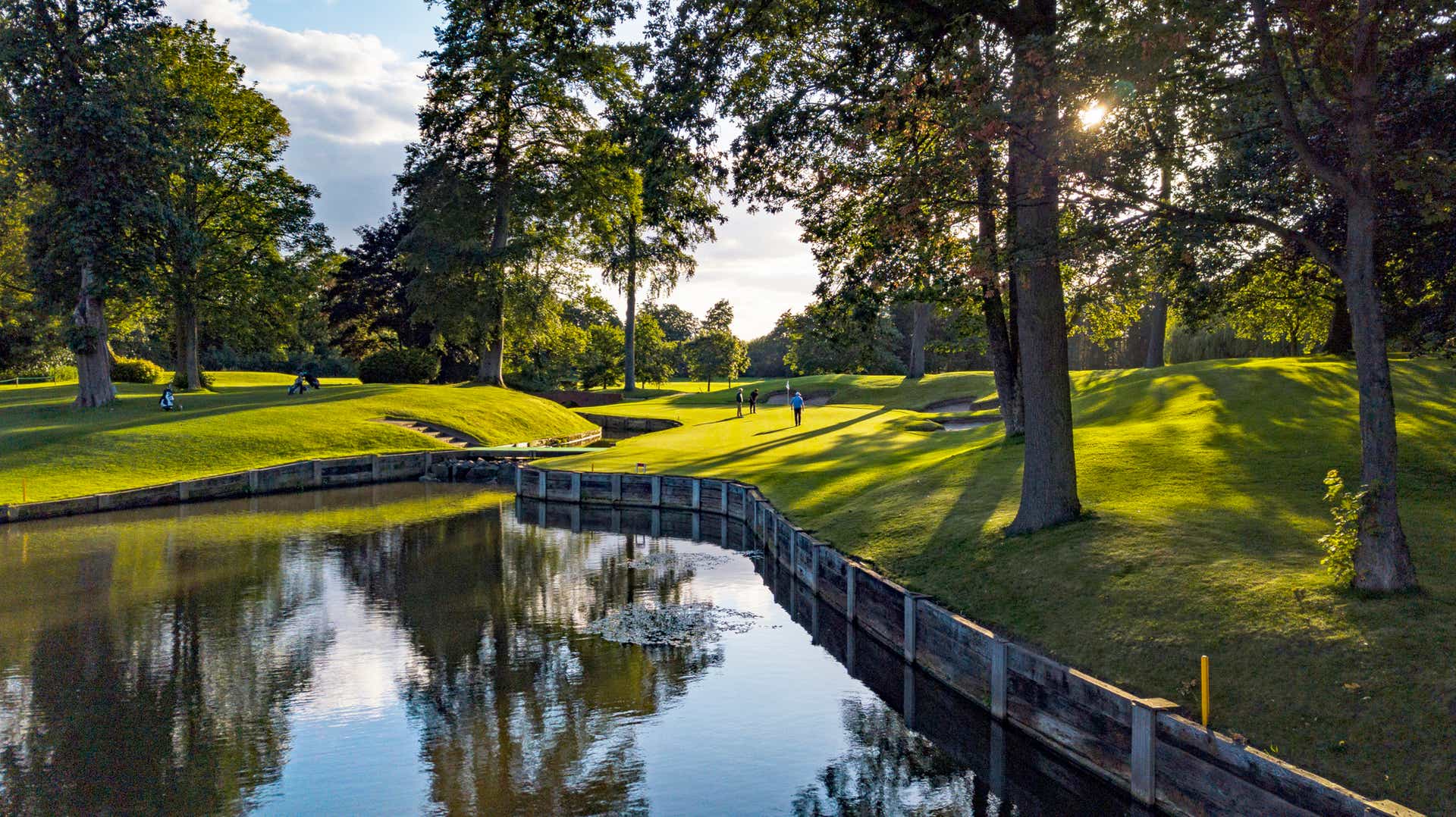Embarking on a Madeira golf trip: On the tee, in the surf and along the levadas

Get first-hand reviews and the latest travel trends with the Golf Travel Experts.

Madeira enjoys a reputation for old-world charm - think fortified dessert wine, cruise ship day trips, peaceful meandering in botanical gardens, Winston Churchill painting seascapes, etc. But what about as an all-action arena for a motley bunch of hyperactive thirty-somethings desperately seeking adventure before the advent of tiny offspring and the onset of Dad-bods render such pursuits more complicated?
Whilst it’s very much “on the map” as a hiking destination - thanks to its dramatic topography, the network of “levadas” (man-made irrigation canals) and trails crisscrossing the island - it’s probably fair to say Madeira’s golf scene isn’t particularly well-known to British golfers. Nor are its variety of challenging but beautiful surf breaks quite as popular as those on the Portuguese mainland or the near(ish) Canaries. All of which increased the allure for our gang, and so here we were in late October, to explore Madeira from tee to green, and from sea to summit.
Golfer teeing off.
We began sunrise at Clube de Golfe Santo da Serra, and there can’t be many more spectacular spots in golf to break one’s fast. Santo da Serra comprises three nines - Machico, Desertas, and Serras. We played Machico and Desertas, which is the preferred championship configuration. The drama begins almost immediately on the second hole, with a precise tee shot over a yawning chasm required. The course boasts views over the Machico peninsula are staggering throughout, which adds to the allure of the game.
The layout was built in 1937 and remodelled in 1991 by Robert Trent Jones Sr, features a bit of water and some of the airiest tee shots I’ve ever experienced - a real challenge on the day we played, with 30mph hot wind strafing from the south.
Coastal views
Many holes play directly down or uphill - like the monstrous 549-yard par 5 Desertas 7th. I normally walk, but rarely have I been more grateful to travel by buggy as at Santo da Serra. Just as we’d hoped, the course was quiet, superbly conditioned and a cracking test. It can’t be overstated what a sublime setting this is to play a round of golf.
Golf buggy
Next, it was time to explore what Madeira had to offer in the water. Whilst its golf courses are found on its eastern flank, many of the surf spots are found on its northern, western, or southern coasts. All spectacular, many of the spots we surfed wouldn’t have looked out of place in Lord of The Rings. If Hobbits surfed. This chunky lefthander beneath the Eye Of Sauron was no exception.
Getting in and out of the water was not straightforward - scrambling over slippery boulders whilst avoiding significant damage to board or bone. This being not uncommon makes Madeira certainly not a surf destination for the faint of heart.
Other spots required some unusual modes of transport to access. Getting on a cable car with a surfboard rather than a snowboard under the arm felt unconventional in the extreme.
Surfer walking into the waves
Located as it is in the middle of the North Atlantic means Madeira gets swell from every direction and is rarely flat. Its reputation in the surf world is as a big-wave mecca. By local standards, it wasn’t huge during our visit, but 2-3m walls of water were plenty to get the pulse racing for landlubbers like me who now spend more time on the golf course than in the brine.
The righthand pointbreaks on Madeira’s southwestern coast are its best-known spots, but with unfavourable wind throughout our week, we instead scored superb lefts in the north that were sheltered by 1000-foot cliffs.
Surf instructor and guide Ruben Afonso, of Madeira Surf Center - which offers everything from beginner lessons (there are some sheltered spots ideal for first-timers) to surf guiding for big-wave surfers - gets stuck in. He was vital in getting us to the right waves at the right time.
Surfer moving along the wave
The second of Madeira’s two golf courses is Palheiro, another sensationally beautiful course perched in the hills overlooking the capital Funchal. This is a rather different test of golf to Santo da Serra - less open and with a wide variety of trees and flora lining many holes. It is a fascinating layout that jams some interesting holes into the varied topography. It reminded me of a subtropical alternative to The Addington.
As they had been at Santo da Serra, Palheiro’s par threes were particularly strong, with the seventh - measuring well over 200 yards from the lofty tips being a fine example, although with my wife Tash going off the reds from less than half the distance, giving her - I felt - rather an advantage!
The 13th green peers out across the sea foliage and niched into the hillside across the way was another very attractive and botanical experience.
Weather is something that needs to be factored in - out of nowhere a pea souper emerged turning a few holes into “mystery golf” - make sure to get a course guide or mapping app to give yourself a chance to navigate if you find yourself faced by a wall of white!
Golfer teeing off down a staggered fairway.
From the ridiculous to the sublime - our group woke before dawn to tackle one of Madeira’s most celebrated hikes - the PR1 trail that culminates in the island’s highest point, the 1861m Pico do Ruivo. Time it right - as we did - and be treated to a majestic sunrise from above the clouds. As with most of Madeira’s marked trails, it’s well signposted, meaning it can be undertaken without a guide.
© Melly Wells
Meandering its way along precipitous galleries hewn into the cliff, along craggy ridges, through inky-block tunnels, and up steep ladders the route is varied and challenging. Leave a half-day, expect all four seasons of weather in that time, and don’t expect to do anything else that afternoon - our group were thoroughly cooked geese after completing the round-trip walk.
Coastal views from a mountain side.
If it’s Old World you want, there’s plenty of that too. We found an eclectic blend of pintxos (previous), seafood and steak on offer in well-priced eateries across the island. While visiting we tried the local speciality “Espetada” - great cast iron skewers of steak suspended from a central mast and placed on the table to gorge upon.
Another favourite was the “Prego Especial” - a kind of garlicky, cheesy steak sandwich, with an extra slice of ham, salad and mayo, all wedged between halves of “Bolo do Caco”, a dense and crispy circular bread roll. These can be had from just about any cafe on the island for as little as three or four euros - a cracking lunch option for whatever activity has gone before.
Traditional church
Driving around the island is quite an experience in and of itself. A programme of tunnelling, bridging and road-building projects since the turn of the century makes it quite straightforward to get around, but as soon as you go “off piste” and onto a smaller road, things get spicy very quickly. This guy didn’t seem perturbed, parking his car as he did on a platform he’d fashioned between the road and his roof.
Parking on the island
Even the more sedate activities on offer can be sportier than you might imagine. There are plenty of saltwater swimming pools around the island, which make for picturesque spots for a swim (there are very few beaches). At the pool in Seixal on the north coast we found a cheerful Argentinian serving up Pina Coladas in whole pineapples - we each had several. Most villages cluster around a church or chapel, in a variety of styles and sizes - we found Baroque, Gothic and Rococo examples all over the island.
It wasn’t quite doing its thing when we were there, but the village of Jardim do Mar (Garden of the Sea) is one of Europe’s best big wave surf spots - it’s well worth a visit if the swell is up, to watch the local guys ride 30-foot monsters down the point in front of the town. On other days, its sleepy passages are worth a wander and don’t miss Joe’s Bar for a pint or few in the evening.
The ocean
We came for a variety of reasons, to pursue a plethora of outdoor pursuits. The Portuguese island of Madeira delivered in spades, on all fronts. I’ll be back for sure, either for another all-action adventure or equally for a more golf-centric gambit.
In the case of the latter, and given the variety of conditions likely to be had, you’d certainly want to play both courses on the main island twice. There’s a third championship course (designed by Seve Ballesteros) on the smaller island of Porto Santo which is - by all accounts, well worth the day trip. Porto Santo is also home to some lovely sandy beaches for a little post-round R&R.
Rocky shoreline.
Published

Golf journalist
Loves to write about golf, ski, surf and adventure

As the world's #1 rated golf tour operator with over 25 years’ experience sending more than 3.5 million golfers away, Golfbreaks is one of the world’s longest established and most trusted golf travel companies. We organise golf breaks, holidays and tournament experiences at over 2,000 resorts and golf courses in the UK, Europe, and further afield.